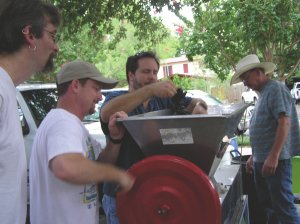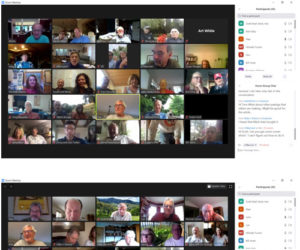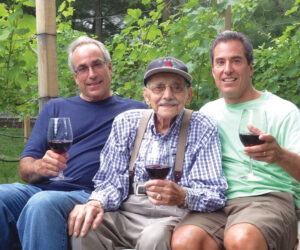
I have a confession: my father was a life-long university chemistry professor who was never proud of his eldest son’s chemistry grades. Sure, I could play “Chem-O” with the best of them! You know, the game where someone calls out “sodium” and you place your 1-Yen coin on Na. Hydrogen gets a coin on H, and so on. Eventually someone shouts out “Chem-O!” That was easy. It was the rest of the chemical mumbo-jumbo that was outright magic.
I diligently drank and brewed a lot of beer. I’d also made cider and mead. And while I had an inkling of making wine someday, I secretly feared the chemistry involved. But last spring, I broke out of my beer-brewing and bought a wine kit. “How much harder could this be than a beer kit?” I thought. You know how the slippery slope starts, and thus I fell.
I soon found a winemaking group that had contracted with a local vineyard to purchase and divvy up one ton (910 kg) of Zinfandel grapes. But I was too late. They had already taken orders and signed contracts with the vineyard manager. Rats. But I resolved to go learn anyway!
In late July, the flatbed with a ton of grapes showed up. It was showtime. Bill announced something like “Brix was 21.0 and pH is 3.25, so we sprayed mumble-mumble milliliters of SO2 on them, but you will want to add about 9 milliliters of 10% SO2 solution per 100 pounds (45 kg).”
Somewhere near the end, it was determined that someone wasn’t able to pick up a 100-lb. (45-kg) allotment and it was up for grabs. I was the only person present who was not in on the original purchase, so I was picked to receive the leftovers!
I had no idea what to do with my grapes. And I knew whatever it was Bill had said earlier was somehow going to be important. So I furiously scribbled notes: Add so much of this at this time, and then add Grand Cru eight hours later. And if you are going to do Malo, don’t add as much SO2 yet. I reassured myself it was just a recipe and I could follow it. No problem. I started reading winemaking books, cruising the Internet for tips, explanations and help. The first thing I realized was that I wanted my Brix up a bit higher than 21, so I dumped in a kilo of cane sugar and stirred. I could have done things slightly worse, of course, but only slightly. When it finally dissolved under vigorous stirring, I measured 23.5 and launched into the recipe. I added yeast starter, punched down, waited, added (0.025 g/lb of crush) of Lafase He Grand Cru color enzyme, waited, added 1.1 g/gal. Tannin VR Supra, and continued to punch down on schedule. I had no idea what I was doing.
Luckily, the yeast knew what to do! My laundry room, and soon the rest of the house, was filled with the wonderful smell of fermentation. Well, except that once the fermentation smell cleared up, it smelled a bit odd. “Green,” I first called it. Maybe vegetal? Herbaceous? It would clear up, certainly. This new-fangled malolactic fermentation in the next step should help! And though the tiny little CO2 bubbles clearly indicated malo was well under way, it just didn’t smell any better yet.
I called out for help. “Bill, Randy! My wine has a really strange smell to it . . . kind of green.” Bill admitted, “Yeah, mine smells vegetal too.” Randy said, “You remember at crush I said you should get this juice off the skins early and press lightly?” Naturally, I didn’t recall any such statement. “Yeah, that fruit had some bunches that were a bit rotten.”
Oh. So we should just toss this and be done with it, right? But Bill advised patience, checking the SO2 level and just letting it sit. And I thought to myself “Bill, how the heck do you check the SO2 level?” So I fired off a quick email, innocently asking “Hey Bill, how the heck do you check the SO2 level?”
It was just a couple months later when I had all the parts for an aeration-oxidation free SO2 test setup. So I called my dad. No, really. I’m 43 years old and I called my dad to explain I’m about to build this chemistry set in my kitchen to do free SO2 testing on my wine. He interrupts, “You probably need to use a good acid, like Phosphoric, right?” “Uh, right.” “Good, so you’ll be making H2SO4 and titrating that.” And I interject, “With NaOH.” And he finished, “In a methyl red/methylene blue indicator, right?”
Meanwhile, rumors started circulating how other members of the group used bentonite, vigorous aerated racking and voodoo and their wine didn’t smell so bad. Challenges were issued; bets were taken and paid, and still, my Zin was atrocious. In fact, everyone’s Zin was atrocious. Couldn’t get it past your nose. It was clear there was no amount of oak sufficient to fix or hide that beast! It was Zin-from-hell!
But even though I had made really lousy wine, I realized that chemistry at this level is not as frightful as I had imagined. I also learned that my father is wiser than his years betray and I should learn more from him while I still can.
My advice is this: Be careful which slippery slopes you approach; one nudge can send you headlong into an enjoyable hobby. And clearly, making good wine requires more than a lot of beer. Starting with good grapes seems important too. In the end, when I realized it did not matter that the wine was bad, it was, I dare say, a Zen Zin moment.




